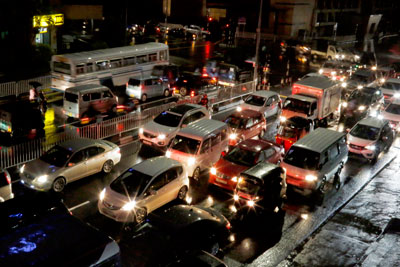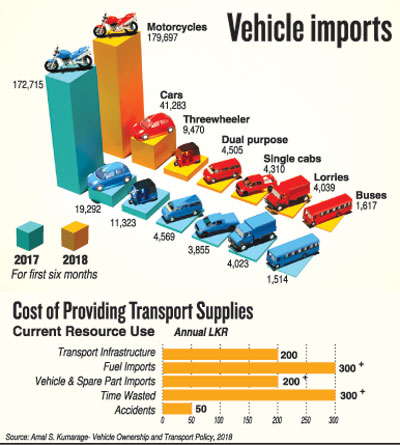News
Traffic speed down to a crawl not just in the city
The thousands of vehicles jamming city roads have reduced metropolitan speeds to an agonisingly slow 10kmph on average despite all the spending on new highways, a transport expert said.

A thumping 6.2 million vehicles have been registered up to now, out of which 4.5 million vehicles are operating on the roads
Outside cities the picture is almost as bad: the average speed on Western Province roads in general is 15kmph, with traffic congestion at record levels – more than one vehicle for every five people, according to research by Senior Professor of the Department of Transport and Logistics at the University of Moratuwa Amal Kumarage.
The lower the average speed, the more time people will spend on the road, Prof. Kumarage pointed out.
“A thumping 6.2 million vehicles have been registered up to now, out of which 4.5 million vehicles are operating on the roads. That is nearly 22 vehicles per 100 people,” Prof. Kumarage said.
Sri Lanka’s population density, which is 38th in the world, does not warrant a high vehicle population, he said. The case was different in vast countries such as America, Australia and Canada, which had low-density populations.
“Sri Lanka’s poor transportation policy, private ownership policy and the poor state of public transport has resulted in the current chaotic situation,” Prof. Kumarage said.
Vehicle registration numbers from February to June 30 this year back up Prof. Kumarage’s concerns.
A total of 41,283 cars were registered, along with 9,470 three wheelers, 179,697 motorcycles, 1,617 buses, 4,039 lorries, 4,310 single cabs and 4,505 dual-purpose vehicles.
These numbers are all up from the same period last year when the Department of Motor Traffic (DMT) showed 19,292 cars registered, 11,323 three-wheelers, 172,715 motorcycles, 1,514 buses, 4,023 lorries, 3,855 single-cab vehicles and 4,569 dual-purpose vehicles.
“Building roads is not the solution as it has created an immense amount of congestion and has taken a large area of land for road,” Prof. Kumarage said. “Improving public transport will save space and also is the most efficient solution to reduce road congestion.”
Public transport infrastructure had to be made more efficient and cost-effective through smart governance, he said, arguing that congested roads were curtailing Sri Lanka’s economic growth, with per capita income at a low $US4,000.
Vehicles had become a social icon, driving up sales of cars. “With very high taxation policies, vehicles are unreasonably priced and the prevailing attitude among people to own a vehicle is for the social status,” Prof. Kumarage said.
The Road Development Authority’s Director of Planning said inadequate road infrastructure was partly to blame for poor traffic flow, and the authority was planning a series of additions to the road network to alleviate this problem.
“Road infrastructure capacity is not the only problem but it is a contributing factor to the traffic congestion,” Engineer Namalie Siyambalapitiya acknowledged.
The current project underway is adjoining the Kelaniya bridge, where a new bridge will be built to connect the Colombo-Katunayake Expressway.
This new Kelaniya bridge will be connected to the Colombo Port over existing roads and this will be extended to connect the extension road of Marine Drive through a tunnel that will be built below the Galle Face area.
Future construction will include a connection from Rajagiriya to the Kelaniya bridge. Rajagiriya will also be connected to the outer circular highway closer to Athurugiriya.
Ms Siyambalapitiya emphasised that infrastructure should facilitate public transport so that people are encouraged to use public over private transport.
“Road infrastructure is comparatively a huge investment so the benefit must also be inclusive to all segments of the population,” she said.
More police are needed to keep the roads orderly, Deputy Inspector General (DIG) of Traffic Lalith Pathinayake said. “With the vehicle numbers on the road increasing by the day, drivers must be made aware of road discipline,” he said.
He pointed out that apart from the spot fine system introduced last week, police also had to inplement the demerit point system in order to alert drivers of the consequences of not conforming to road rules.

